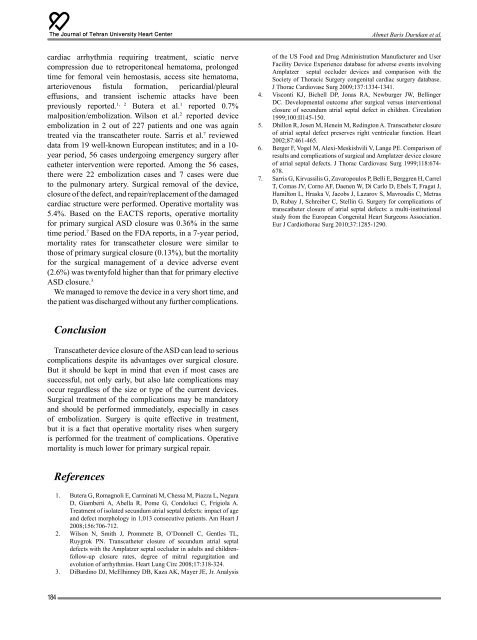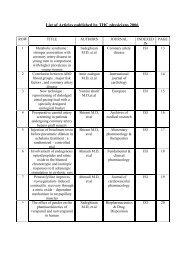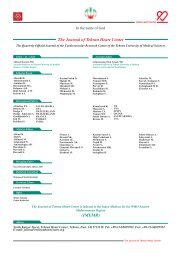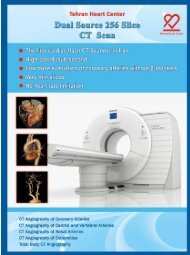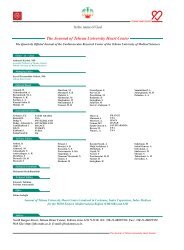THE JOURNAL OF TEHRAN UNIVERSITY HEART CENTER
THE JOURNAL OF TEHRAN UNIVERSITY HEART CENTER
THE JOURNAL OF TEHRAN UNIVERSITY HEART CENTER
You also want an ePaper? Increase the reach of your titles
YUMPU automatically turns print PDFs into web optimized ePapers that Google loves.
The Journal of Tehran University Heart Center<br />
Ahmet Baris Durukan et al.<br />
cardiac arrhythmia requiring treatment, sciatic nerve<br />
compression due to retroperitoneal hematoma, prolonged<br />
time for femoral vein hemostasis, access site hematoma,<br />
arteriovenous fistula formation, pericardial/pleural<br />
effusions, and transient ischemic attacks have been<br />
previously reported. 1, 2 Butera et al. 1 reported 0.7%<br />
malposition/embolization. Wilson et al. 2 reported device<br />
embolization in 2 out of 227 patients and one was again<br />
treated via the transcatheter route. Sarris et al. 7 reviewed<br />
data from 19 well-known European institutes; and in a 10-<br />
year period, 56 cases undergoing emergency surgery after<br />
catheter intervention were reported. Among the 56 cases,<br />
there were 22 embolization cases and 7 cases were due<br />
to the pulmonary artery. Surgical removal of the device,<br />
closure of the defect, and repair/replacement of the damaged<br />
cardiac structure were performed. Operative mortality was<br />
5.4%. Based on the EACTS reports, operative mortality<br />
for primary surgical ASD closure was 0.36% in the same<br />
time period. 7 Based on the FDA reports, in a 7-year period,<br />
mortality rates for transcatheter closure were similar to<br />
those of primary surgical closure (0.13%), but the mortality<br />
for the surgical management of a device adverse event<br />
(2.6%) was twentyfold higher than that for primary elective<br />
ASD closure. 3<br />
We managed to remove the device in a very short time, and<br />
the patient was discharged without any further complications.<br />
of the US Food and Drug Administration Manufacturer and User<br />
Facility Device Experience database for adverse events involving<br />
Amplatzer septal occluder devices and comparison with the<br />
Society of Thoracic Surgery congenital cardiac surgery database.<br />
J Thorac Cardiovasc Surg 2009;137:1334-1341.<br />
4. Visconti KJ, Bichell DP, Jonas RA, Newburger JW, Bellinger<br />
DC. Developmental outcome after surgical versus interventional<br />
closure of secundum atrial septal defect in children. Circulation<br />
1999;100:II145-150.<br />
5. Dhillon R, Josen M, Henein M, Redington A. Transcatheter closure<br />
of atrial septal defect preserves right ventricular function. Heart<br />
2002;87:461-465.<br />
6. Berger F, Vogel M, Alexi-Meskishvili V, Lange PE. Comparison of<br />
results and complications of surgical and Amplatzer device closure<br />
of atrial septal defects. J Thorac Cardiovasc Surg 1999;118:674-<br />
678.<br />
7. Sarris G, Kirvassilis G, Zavaropoulos P, Belli E, Berggren H, Carrel<br />
T, Comas JV, Corno AF, Daenen W, Di Carlo D, Ebels T, Fragat J,<br />
Hamilton L, Hraska V, Jacobs J, Lazarov S, Mavroudis C, Metras<br />
D, Rubay J, Schreiber C, Stellin G. Surgery for complications of<br />
transcatheter closure of atrial septal defects: a multi-institutional<br />
study from the European Congenital Heart Surgeons Association.<br />
Eur J Cardiothorac Surg 2010;37:1285-1290.<br />
Conclusion<br />
Transcatheter device closure of the ASD can lead to serious<br />
complications despite its advantages over surgical closure.<br />
But it should be kept in mind that even if most cases are<br />
successful, not only early, but also late complications may<br />
occur regardless of the size or type of the current devices.<br />
Surgical treatment of the complications may be mandatory<br />
and should be performed immediately, especially in cases<br />
of embolization. Surgery is quite effective in treatment,<br />
but it is a fact that operative mortality rises when surgery<br />
is performed for the treatment of complications. Operative<br />
mortality is much lower for primary surgical repair.<br />
References<br />
1. Butera G, Romagnoli E, Carminati M, Chessa M, Piazza L, Negura<br />
D, Giamberti A, Abella R, Pome G, Condoluci C, Frigiola A.<br />
Treatment of isolated secundum atrial septal defects: impact of age<br />
and defect morphology in 1,013 consecutive patients. Am Heart J<br />
2008;156:706-712.<br />
2. Wilson N, Smith J, Prommete B, O’Donnell C, Gentles TL,<br />
Ruygrok PN. Transcatheter closure of secundum atrial septal<br />
defects with the Amplatzer septal occluder in adults and childrenfollow-up<br />
closure rates, degree of mitral regurgitation and<br />
evolution of arrhythmias. Heart Lung Circ 2008;17:318-324.<br />
3. DiBardino DJ, McElhinney DB, Kaza AK, Mayer JE, Jr. Analysis<br />
184


